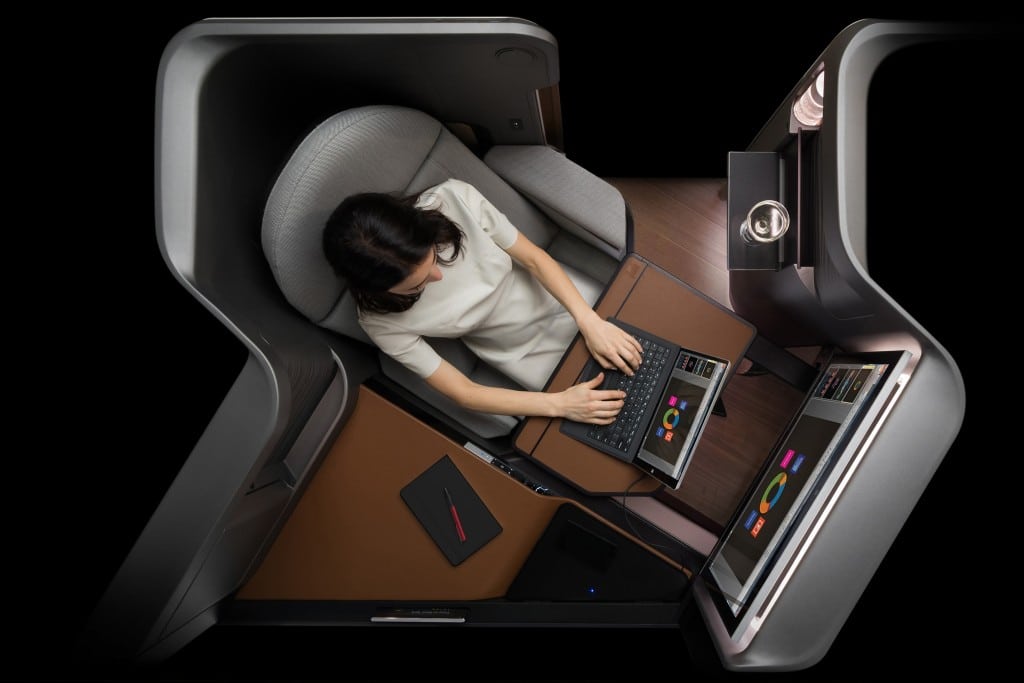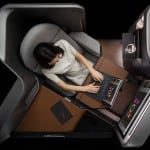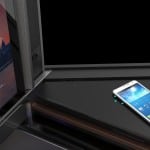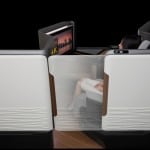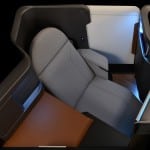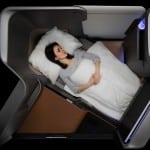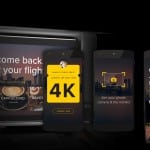Skift Take
It’s no surprise that the group which partnered to design the new Waterfront Business class seat chose to first reveal the product at CES 2016. Not only is it a Panasonic product, in collaboration with B/E Aerospace, Formation Design and Teague, but it was also designed to fit the new hyper-connected business traveler.
- Waterfront seat concept.
- Waterfront seat concept.
- Waterfront seat concept.
- Waterfront seat concept.
- Waterfront seat concept.
- Waterfront seat concept.
- Waterfront seat integrated technology.
As aircraft interior design evolves, we’re getting closer to the promise of a smart seat which will remember passenger preferences, making air travel more comfortable and familiar.
The new Waterfront Business class seat, submitted for this year’s Crystal Cabin Awards, is ready to take flight.
The Waterfront is a next-generation premium travel experience at the nexus between physical comfort and digital convenience. It creates a responsive environment, tailored to passenger travel preferences, which seamlessly links to passenger personal electronic devices, creating what the designers describe as a “dynamic and versatile connected seating environment.”
Features include a wireless link to an advanced in-flight entertainment (IFE) system created by Panasonic, which is part of the collaborative team behind the Waterfront. The IFE system will give passengers a cinematic experience with a 4K touch-screen monitor which can also be controlled by a second screen-controller.
Environmental controls are personalized. Lighting is automatically adjusted to fit passengers’ activities. Seat heating, cooling and air flow are precisely adjusted to passenger preferences. The Waterfront can also power personal electronic devices with inductive charging.
Innovation through Collaboration
We spoke to the design team at Teague, about this collaborative project with Panasonic, B/E Aerospace, and Formation Design.
“A lot of the inspiration came from the rise in personal devices,” says Brian Conner, Teague’s creative director.
“People are bringing lots of data about them onto the aircraft. By making those devices part of the seating environment. Making those devices work with the seating environment enhances the experience. They can connect and automatically set language preferences, what they’d like to drink, privacy,entertainment, make arrangements for travel on the ground,” he adds.
The collaborative team hopes to use the seat to join-up the divided passenger experience through technology that connects from pre-flight to inflight and back on the ground.
It will also use technology to bring the crew closer to passengers by interfacing with crew electronic devices. For example, when passengers set privacy on the seat, the crew will know not to disturb them. Likewise, when the passenger is ready for a meal, the crew are instantly notified.
The Waterfront is an evolution of last year’s Economy Jazz seat, also developed by the collaborative team of designers and manufacturers, which was nominated for a Crystal Cabin award last year. Like the Waterfront, the Jazz seat was designed for high-tech travelers, but those flying in the Economy cabin.
“The inception of the Waterfront project was a second generation of the Jazz seat,” Conner explains. “It was really successful because it was the first time a seat supplier and IFE supplier got together rather than working separately. That turned out really well. When we saw what we could do, it was an inspiration for the new Waterfront Business class project.”
New Trends Meet Old Habits
Teague says the Waterfront concept is production-ready and could be built quickly.
While Teague says some airlines have already expressed interest, the concept of a fully rolled-up seat — that is a seat that comes complete with all components from the factory — is a relatively new concept for airlines.
Generally, manufacturing of the seat happens in isolation. Built seats are kitted out with individual components, including IFE, based on airline specifications. This process generally works out, but it is time-consuming and expensive for all involved.
Altering combinations of seat entertainment options requires that each seat be individually certified, in addition to the certifications required to customize the seat appearance to fit the airline brand.
Getting around that customization process, by presenting a complete seat, is ideal for manufacturers, and could benefit airlines on costs.
But airlines often negotiate individual contracts for each component directly with the manufacturer — so separate contracts are made for IFE which can encompass an airline’s fleet ensuring maximum discounts.
That might make airlines loathe to mix and match IFE manufacturers. Airlines are also notoriously resistant to change.
We asked Teague whether the group expects this to be a problem.
Chris Pirie, Business Development Senior Director at Teague, argues that it’s really a matter of re-educating the market on the benefits of buying a fully rolled-up product.
“Think about mobile phones,” he says. “Mobile phone manufacturers used to make the phone, and others wrote the software. The result was choppy. Apple changed that, by designing around the whole user experience—holistically.”
Pirie also equates this whole model seat to trends in the automotive industry.
“Car companies realized they could own the product,” he says. “As an integrated package. We could make this a new business model. The challenge, of course, is to make sure we’re still offering customers choice. That’s the challenge the industry faces. It allows the clients to have flexibility.”
While Pirie admits the industry is not quite there yet, he believes airlines can be persuaded to change purchasing behavior as more products developed in this way come to market.
“We’re seeing a lot of collaboration between brand manufacturers and Teague,” he says. “We’re sitting in meetings where we’re representing airlines, though airlines are still buying the products.”
Customer First
The Economy Jazz seat, which inspired the Waterfront, is also envisioned as a fully rolled-up product, and other manufacturers have presented similar single-source concepts that could help build an appreciation for the benefits.
The collaborators behind the Waterfront are primarily concerned with the benefits to flyers. The seat is designed for and around the passenger, to enhance the air travel experience.
Pirie describes the collaboration as “a much more thoughtful” design process. “It was a real turning point to discovering how crucial collaboration is to making a better product,” he says.
The Daily Newsletter
Our daily coverage of the global travel industry. Written by editors and analysts from across Skift’s brands.
Have a confidential tip for Skift? Get in touch
Tags: B/E Aerospace, panasonic, teague
Photo credit: This Waterfront seat concept from Teague, Panasonic, B/E Aerospace, and Formation Design is an entrant for this year's Crystal Cabin Awards. Teague
